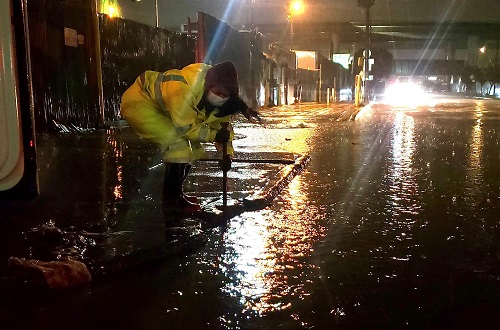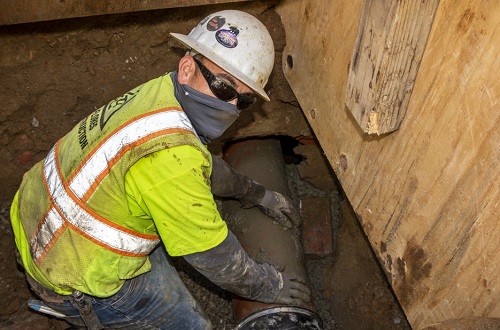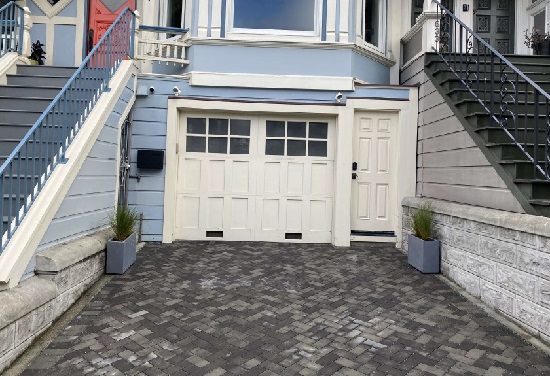Resources to Get You Rain Ready
Improving stormwater management and flood resilience across the City is a partnership between government and residents like you.
In San Francisco, we have a combined system that collects both stormwater and sewage in the same set of pipes. When the system reaches capacity in heavy rains, we can experience street flooding (especially in low-lying areas that used to be creeks or bays) and property damage. No sewer system, including San Francisco's, can be designed to manage all stormwater in ALL storms. Year-round, our crews clean, repair and replace aging sewer infrastructure through capital projects and preventative operations and maintenance. Before, during and after the rainy season, our dedicated Stormwatch Team inspects, monitors and cleans storm drains, pipes and anything in-between.

Floodwater Grant
Provides up to $100,000 to implement approved flood-protection projects for eligible property owners (who have experienced flooding coming from the sewer system or public right-of-way as a result of heavy rains).

Purchase Flood Insurance
Cover flood damage to buildings and building contents (renters are eligible for content coverage) through the National Flood Insurance Program. If you are an insurance broker, you can sell flood insurance in SF to property owners and renters.

Protect Your Property
Work with your plumber to regularly inspect and maintain your sewer lateral (the connection from your building to the city sewer). Tree roots, wipes and grease poured down the drain can clog your sewer pipes and cause backups.

Install Green Infrastructure
Install green infrastructure on your property (such as rain gardens, permeable pavement/driveways, rainwater harvesting systems, and more) to capture stormwater and become eligible to apply for a stormwater credit to lower your monthly sewer bill.
Plan Ahead and Prepare for the Rains
- Apply for a Flood Disaster Relief Grant - led by the Office of Small Business, a division of the Office of Economic and Workforce Development (OEWD), if the winter storm flooding significantly damaged your business.
- Find out if your property is in the 100-year storm flood risk map
- Pick up free sandbags from San Francisco Public Works.
- Elevate belongings in your garage and any low-lying areas on your property. Remember to store emergency items, such as first aid kits, flashlights and portable radios, in a safe and high place.
-
Learn What to Do When a Sewer Backup or Flooding Occurs
When to Contact a Plumber
Typical SF Property with Sewer Lateral Info
If you experience a backup from your plumbing or flooding, contact a plumber. A plumber can confirm where the issue is your house plumbing or sewer lateral. Depending if the issue is located in the upper (between the property and curb) or lower part (between the curb and sewer main under the roadway) of the sewer line will determine if the city of San Francisco or the property owner is responsible to fix the issue. Learn what property owners need to do for their sewer laterals at sfpuc.gov/SewerLaterals.
Report Flooding
Please report flooding due to a rainstorm to the City’s Customer Service Center at sf311.org, via the mobile app, or by phone at 3-1-1. Select “Flooding & Sewer” request so your report will be forwarded to the appropriate City agency.
Health and Safety Tips
Floodwater can contain contaminants washed off the street, including bacteria and parasites. Avoid coming into direct contact with floodwater and keep children and pets away. If you must encounter floodwater, follow these precautions:
- Wear waterproof boots, gloves, eye protection and clothes that are either water resistant or disposable.
- Keep exposure with floodwater to a minimum, avoid splashing, and keep the water out of your mouth, eyes and nose.
- Bathe or shower thoroughly with soap and water, wash all contaminated clothing in hot water and a detergent after you come in contact with floodwater.
- Make sure tetanus immunizations are up to date. If you are on chemotherapy or any health issue that weakens the immune system, consult with your primary health care provider.
- If you become ill with fever, nausea, vomiting or diarrhea after exposure to possibly contaminated floodwaters, contact your health care provider.
- Electrical hazards: When entering flooded areas, be aware of electrical hazards. Don’t touch any electrical equipment unless you are absolutely sure it is properly grounded or that the power is off. Also, don’t operate any electrical equipment that is not specifically designed for use in wet locations.
- Never handle a downed power line. If clearing or other work must be performed near a downed power line, contact the utility company. PG&E suggests that you shut off your gas and electricity during major flooding, if you know how to do so safely. Visit PG&E’s emergency preparedness page or call them at (800) 743-5000. Do not attempt to do so if you must stand in or make contact with water.
- Carbon Monoxide: Operate all gasoline-powered devices outside. These devices release carbon monoxide, a deadly, colorless and odorless gas.
- Never assume that water-damaged structures or ground are stable.
- Cover or close vents, such as heater vents, to prevent spreading of contaminants and odors.
Cleanup
- Remove any excess water from the property by using pumps or by mopping.
- If you have a large amount of water in your basement and no drain present, you may need to buy or rent a sump pump to get rid of the water.
- Consider using an insured professional cleaning service.
- Wear gloves while cleaning and wash hands thoroughly after handling any soiled items.
- Clean hard surfaces such as floors and fixtures with hot water and a mild detergent. Rinse it with a bleach solution: ¼ cup of liquid household bleach to one gallon of water.
- CAUTION: Do not mix bleach with other cleaning products that contain ammonia.
- Saturated fabrics including carpeting, usually cannot be adequately cleaned.
- Disinfect mops, brooms, and brushes used for clean-up with a bleach solution.
- Yards that have been contaminated by floodwater should be disinfected by a liberal application of lime. Children and animals should be kept away from limed areas until the lime is no longer visible.
Mold
Extreme storms and flood events increase exposure to indoor dampness and mold. The most important thing you can do to prevent mold growth is to identify and remove the source of water and then dry out your home within 48 hours.
- Use dehumidifiers and active ventilation.
- Remove and dispose of mold-contaminated materials.
- Avoid breathing dust (fungal spores) generated by wet materials. Consider using an N-95 NIOSH-approved disposable respirator.
- After working with mold-contaminated materials, wash thoroughly, including the hair, scalp, and nails. For more information see information from SFClimateHealth.
Food Safety
- Discard any food, drinking water or medicines that may have come into contact with floodwater.
- Undamaged, commercially canned foods can be saved if you remove the can labels, thoroughly wash the cans, and then disinfect them with a solution consisting of one cup of bleach in 5 gallons of water. Relabel your cans, including expiration date, with a marker.
- Food containers with screw-caps, snap-lids, crimped caps (soda pop bottles), twist caps, flip tops, and home canned foods should be discarded if they have come into contact with flood water because they cannot be disinfected.
- For infants, use only pre-prepared canned baby formula that requires no added water.
Keep Records of Damage and Cleanup
- Take pictures and videos! Be sure to document damages when possible.
- For National Flood Insurance, contact your local insurance agent or go to: https://www.floodsmart.gov or call 1-800-427-4661.
- If you think the city caused damage to your property, you may contact the City’s Attorney’s Office Claims Division at 415-554-3900 and/or file a claim with the San Francisco Controller’s Office at sfcityattorney.org/claims. Records such as 311 calls, photos, receipts should also be provided.
How You Can Help
- Join our Adopt a Drain and Rain Guardians programs to adopt one of the 25,000 storm drains (or catch basins) or rain gardens in our beautiful city and pledge to keep it free of debris and help minimize risk of flooding.
- Please report clogged catch basins, street flooding, sewer backups or wastewater odors to 311 online at sf311.org, on the app for Android and iPhone, or by calling 3-1-1.
Contact Us
If you have other questions on how to get ready, please contact us at RainReadySF@sfwater.org or 415-554-3289 (this mailbox is checked daily while we’re working remotely).
The SFPUC RainReadySF Team thanks you in advance for your efforts as our partner to create a rain ready San Francisco!

